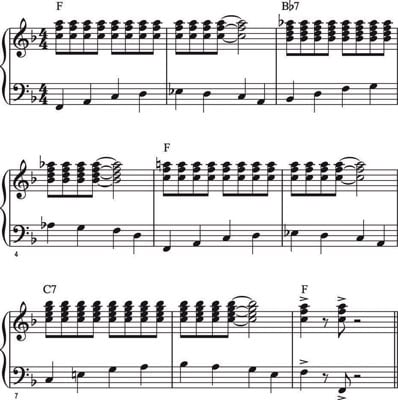Following, are several excellent left-hand accompaniment patterns you can use for your piano playing. Along with the explanations, you'll find links to audio tracks, along with how to find them on the Dummies.com web page.
It’s important to practice these patterns again and again to master the right notes and the way each pattern feels under your fingers. The more comfortable you are with the pattern, the more easily you can apply it to any key, any chord, and any scale.
Fixed and broken chords
The easiest left-hand accompaniment is chords, whether you play them as straight chords or arpeggios. Start with the basic chords and find inversions that work well for you without requiring your left hand to move all over the keyboard. Also, you should experiment with various rhythmic patterns. For example, try playing quarter-note chords instead of whole-note chords. Or try a dotted quarter and eighth-note pattern.Here, the left hand plays a simple chord progression with several different rhythmic patterns. You can listen to these left-hand chords here (select Book IV, Chapter 2, Audio Track 72). Play these a few times and decide which rhythmic pattern works, sounds, and feels best to you.
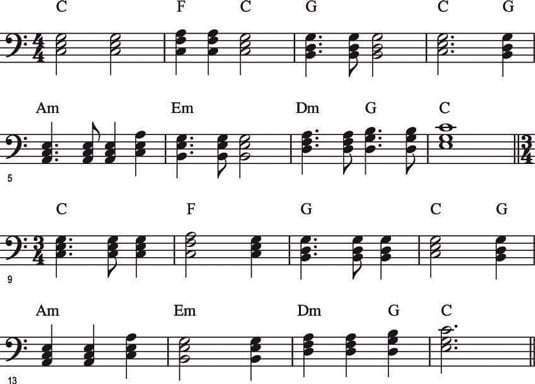
You can change the texture and add some variety with a constant arpeggiated pattern in the left hand. For every chord symbol, use the root, fifth, and octave notes of the chord’s scale to form an up-and-down pattern throughout the song. This pattern works for fast or slow songs.
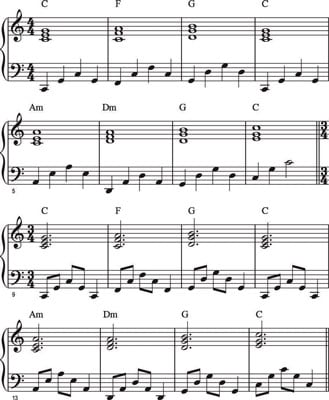
To play a song using the left-hand accompaniment, play “Love Me Like You Used To” (select Book IV, Chapter 2, Audio Track 91).
Chord picking
Left-hand chord picking is a style well suited to country music. But even if you aren’t a fan of that genre, you can apply this pattern to just about any song you like.Most chords are made up of a root note, a third interval, and a fifth interval. You need to know these three elements to be a successful chord-picker.
To play this pattern, break a chord into two units: the root note and two top notes. Play the root note on beat 1 and the top two notes together on beat 2. To make it sound even more impressive, do something a little different on beat 3: Play the fifth of the chord by itself but one octave Lower.
Now try playing this pattern in the piece “Picking and Grinning” (select Book IV, Chapter 2, Audio Track 74). After you get the feel of this bouncy rhythmic pattern, you won’t even need to look at your hands. Your pinky will find the two alternating bass notes because they’re always the same distance from the root.
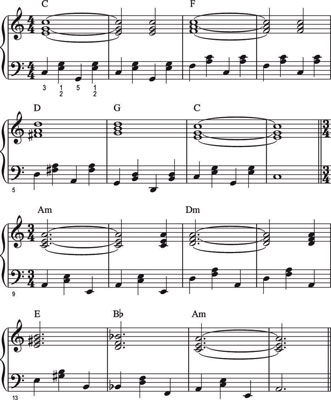
Octave hammering
This easy (if tiring) left-handed groove is really fun and easy if your right hand is just playing chords. But if you’re playing a melody or something more complicated than chords with your right hand, this pattern may not be a practical choice.To hammer out some octaves, you simply prepare your left hand in an open octave position, with your pinky and thumb ready on the two notes, and make sure your wrist is loose enough to bounce a bit with the appropriate rhythm.
When the chord changes, keep your hand in octave position as you move directly to the next set of octaves. You can play the octaves using any rhythm that sounds good to you — try whole notes, half notes, even eighth notes, depending on the rhythmic character of the song.
“Octaves in the Left” (select Book IV, Chapter 2, Audio Track 75) lets you roll out some octaves.
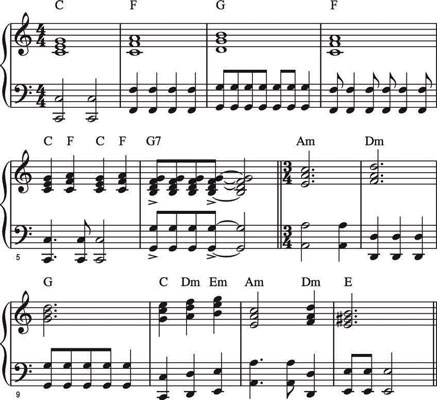
As you become more familiar with harmony, you can add to these left-hand octave patterns with octaves built on the notes of the chord.
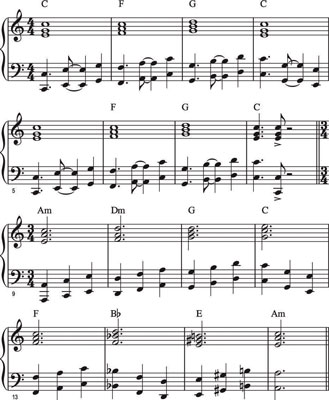
Bouncy rock patterns
In addition to slamming octaves, a nice rock and roll-sounding bass pattern may use other intervals drawn from scale notes.You can create a great bass pattern using the octave, the fifth, and the sixth intervals of each chord. Try this rockin’ accompaniment along with “Rockin’ Intervals” (select Book IV, Chapter 2, Audio Track 77). You can modify the pattern to fit a two- or one-measure pattern in 4/4 meter. After a few times through, your hands will know what to do, and you can apply the pattern to any major chord.
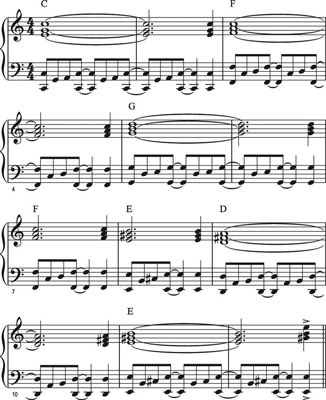
The great Chuck Berry made the locomotive-sounding pattern demonstrated in “Berry-Style Blues” very popular on the guitar. It was only a matter of time before some trail-blazing pianist adapted this guitar pattern to the piano. All you have to do is alternate between playing an open fifth and an open sixth on every beat. Listen to “Berry-Style Blues” (select Book IV, Chapter 2, Audio Track 78).
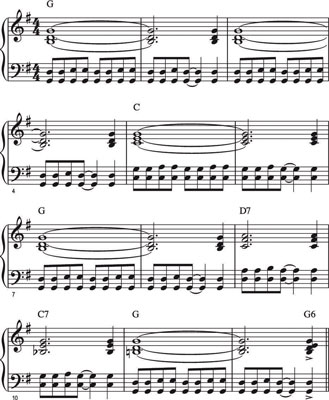
Melodic bass lines
Some left-hand patterns are so widely used that they’re better known than the melodies they accompany. Listen to “Bum-ba-di-da” (select Book IV, Chapter 2, Audio Track 79) — one such pattern that was made famous by Roy Rogers in his show-closing song, “Happy Trails.” All you need are three notes from each chord’s scale: the root, the fifth, and the sixth. Play them back and forth, over and over.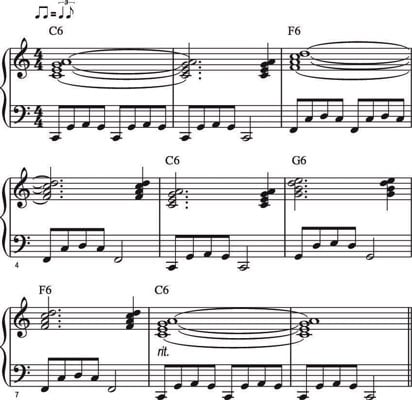
Another melodic left-hand pattern played by every pianist from novice to pro is the “boogie-woogie” bass line. It doesn’t even need a melody. This bass line uses notes from a major scale but lowers the seventh note of the scale a half step (also called a flatted seventh) to give you that bluesy sound.
For each new chord in the boogie-woogie bass line (select Book IV, Chapter 2, Audio Track 80), you play the following scale notes up the keys and then back down: root, third, fifth, sixth, flatted seventh.
